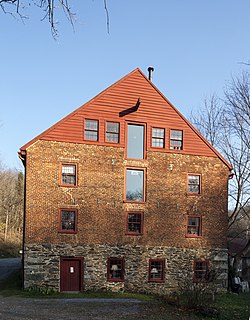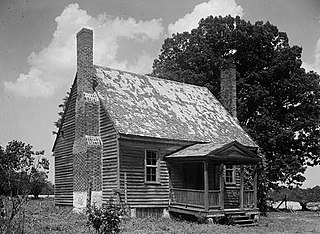
Pickens, formerly called Pickens Courthouse, is a city in Pickens County, South Carolina, United States. The population was 3,126 at the 2010 census. Pickens changed its classification from a town to a city in 1998, but it was not reported to the Census Bureau until 2001. It is the county seat of Pickens County. It was named after Andrew Pickens (1739–1817), an American revolutionary soldier and US Congressman for South Carolina.

Lewis Mill Complex is a historic grist mill complex located at Jefferson, Frederick County, Maryland. The complex consists of seven standing structures, a house foundation, and the remains of an earlier millrace. It centers on an early 19th-century three-story brick mill structure with a gabled roof. The mill complex served German immigrant farmers in Middletown Valley between 1810 and the 1920s. It was rehabilitated in 1979-1980 for use as a pottery shop. Also in the complex are a stuccoed log house and log springhouse built about; a frame wagon shed and corn crib structure and frame barn dating from the late 19th century; and early 20th century cattle shelter and a frame garage.

Hagood Mill is an operational water-powered gristmill built in 1845 by James Hagood near Pickens, South Carolina. It was listed in the National Register of Historic Places in 1972.

Colvin–Fant–Durham Farm Complex, also known as the Nicholas Colvin House and Durham House, is a historic home and farm complex and national historic district located near Chester, Chester County, South Carolina. The district encompasses six contributing buildings. The house was built about 1835, and is a vernacular farmhouse with transitional Federal and early Greek Revival detailing. The house consists of a two-story, hall and parlor plan, frame main block and a one-story, frame dining room and kitchen ell, which was added in the late-19th century. The property also includes a smokehouse, well house/power house, mule barn, tenant house, and a log cottonseed house.

Browntown is a national historic district located near Johnsonville, Florence County, South Carolina. The district encompasses 7 contributing buildings and 4 contributing structures reflecting the self-sufficient way of life practiced by several generations of the Brown family during the 19th and early-20th centuries. Moses Brown and his son and grandsons were self-sufficient farmers who operated their own brick kiln, grist mill, lumber mill, cotton gin, retail and wholesale mercantile business, and school. The property nominated includes the cotton gin building, three residences, the school, a tobacco barn, and several outbuildings. Browntown includes examples of both log and frame construction, and are grouped in two complexes, one group adjacent to the road and the other across the fields around the cotton gin building.

The Contoocook Mills Industrial District of Hillsborough, New Hampshire, encompasses the industrial mill complex of the Contoocook Mills, a major business in the town from the 19th century to the mid-20th century. Industry on the banks of the Contoocook River in Hillsborough began as early as 1763, when a sawmill and gristmill were operated in the area. More modern industrial activity began in 1828 with the construction of a cotton mill by Josiah Marcy. This three story timber frame building stands on the south side of Mill Street, on a granite foundation through which a raceway provide the water which powered the mill. Marcy expanded his operations, building a grist mill and saw mill before his death in 1848. The grist mill, a handsome brick building on the north side of Mill Street, was operated as such until 1884, after which it was converted into the picker building for the main mill complex.

Boykin Mill Complex, also known as Mill Tract Plantation, is a national historic district located near Camden, Kershaw County, South Carolina. The district encompasses nine contributing buildings, two contributing sites, and four contributing structures. “Boykin Mill” denotes a community which consists of an old post office, an old general store, a c. 1905 grist mill, mill pond, mill dam, gates, and canals. The community also includes an early 19th-century Greek Revival style Baptist church, one mid-19th-century residence, three 20th-century residences built for mill workers, and a smoke house. An American Civil War battle site is also a part of the Boykin Mill community. The Battle of Boykin's Mill took place on April 17, 1865.
Williams–Ligon House, also known as Cedar Rock Plantation and Magnolia Estates, is a historic home and farm complex located Easley, Pickens County, South Carolina. The house was built in 1895, and is a two-story, frame I-house with a one-story rear addition. It features Folk Victorian decorative elements including spindle work and turned porch posts and balusters and brackets. Also on the property are a contributing barn that was the original Williams house, a smokehouse, and several mid-20th century barns and farm buildings.
Ellerbe's Mill, also known as Millvale, is a historic grist mill complex located near Rembert, Sumter County, South Carolina. The mill was built about 1830, and is a 2 1/2-story pine clapboard building mounted on wooden pilings situated on a 90-acre millpond. Also located on the property is the associated store (1910); the two-story, frame Victorian style main house ; several tenant houses; and a dovecote.
Brushy Creek, also known as Vardry McBee House and Alexander McBee House, is a historic home located at Greenville, South Carolina. It was built about 1836 as a 1+1⁄2-story, frame farmhouse. In 1924, the house was expanded with the addition of a one-story frame room, that incorporated the formerly separate kitchen into the house itself. Further renovations were made in 1938–1939 and 1951. Also on the property are a log barn, a brick shed, a well house, and the ruins of a grist mill. It was the home of Vardry McBee (1775–1864), prominent 19th-century businessman, entrepreneur, and delegate to the Secession Convention of Greenville District known as the “Father of Greenville,” and his son Alexander McBee (1822–1897), prominent 19th-century businessman, banker, and state representative of Greenville District.

Glencoe Mill Village Historic District is a national historic district located at Glencoe, Alamance County, North Carolina. It encompasses 48 contributing buildings and 6 contributing structures built between 1880 and 1882 in Glencoe.

Easley Mill is a historic mill complex in Easley, South Carolina. The mill was the first of three built in Easley between 1899 and 1910. The main building was completed in 1900, and is a four-story brick structure designed by preeminent mill architects Lockwood, Greene & Co. It was built during a boom in the textile industry across the Southern United States; more than 70 mills were opened in South Carolina alone between 1895 and 1903. The mill met with immediate success, including large shipments for export to China. By 1907, the mill contained over 37,000 spindles and 1,000 looms, and employed 500. It was sold to Woodside Mills of Greenville in 1920, and to Dan River, Inc. in 1956, who operated the mill until 1990. The mill has a shallow-pitched hip roof with bracketed eaves. Most of the arched window openings have been bricked over. Other structures on the site include a one-story office building, a warehouse, smokestack, an ice house, water tower, and monument to the mill's founder, John Mattison Geer. The mill was listed on the National Register of Historic Places in 2013. A proposal was made to convert the building to apartments in 2019.
Hadley House and Grist Mill is a historic home and grist mill located near Pittsboro, Chatham County, North Carolina. The house was built about 1858, and is a two-story, three bay by two bay, Greek Revival style frame dwelling. It has a one-story rear ell and one-bay front porch, and sits on a stone foundation. The mill dates to 1885, and is a three-story frame structure on a stone foundation. It has an exterior iron mill wheel measuring 16 feet in diameter. The mill continued in operation until the 1930s. Also on the property are the contributing two-story frame smokehouse, foundation stones for the original detached kitchen and quarters, and archaeological remains.

Cascine is a historic plantation complex and national historic district located near Louisburg, Franklin County, North Carolina. The district encompasses 12 contributing buildings, 4 contributing sites, and 3 contributing structures. The main house was built about 1850, and is a large two-story, Greek Revival style frame dwelling, in the manner of Jacob W. Holt, with Gothic Revival style influences. Also on the property is a small, one-story frame dwelling dated to about 1752. It was repaired and refurbished in the mid-20th century. Also on the property are the contributing brick kitchen, frame stable, granary, carriage house, family cemetery, slave cemetery, remains of slave quarters, tenant house, six log and frame tobacco barns, grist mill complex, and archaeological sites.

Laurel Mill and Col. Jordan Jones House is a historic home and grist mill located near Gupton, Franklin County, North Carolina. The house was built about 1850, and is a one-story Greek Revival / Italianate style frame cottage over a raised brick basement. The frame mill building is two stories tall supported by large stone piers. The mill building extends over Sandy Creek. The house and mill are all that remains of the ambitious local industrial complex.
Clifton House and Mill Site is a historic home and grist mill site located near Royal, Franklin County, North Carolina. It was built in the 1850s, and is a two-story, rectangular frame house with a hipped roof in the Greek Revival style with Italianate design elements. It features a two-story pedimented front porch and has a two-story rear ell. Also on the property are two contributing 19th-century outbuildings, Miller's House, and the ruins of a grist mill built about 1831, including some machinery.
Rufus Amis House and Mill is a historic home and grist mill and national historic district located near Virgilina, Granville County, North Carolina. The house was built about 1855, and is a 1 1/2-story, "L"-shaped Gothic Revival / Greek Revival style frame dwelling. It has a roof with six gables and delicately sawn bargeboards. Also on the property are the contributing smokehouse, icehouse, privy, barn, chicken house, corn crib, mill race, former dwelling, and 3 1/2-story grist mill.

Faucett Mill and House, also known as Coach House and Chatwood, is a historic grist mill, home, and national historic district located near Hillsborough, Orange County, North Carolina. The mill was built before 1792, and is a 2+1⁄2-story, heavy timber frame, weatherboarded building. It is sided alongside a reconstructed mill race and the Eno River. The Faucett House was built about 1808, and is a 2+1⁄2-story, Federal style frame dwelling, with an original one-story rear wing. The house's southwest wing was originally a separate dwelling known as the Naile Johnson House. It was added to the Faucett House about 1938. Also on the property are the contributing mill cottage, barn, and a section of the "Great Road."
Shuping's Mill Complex was a historic grist mill complex located near Faith, Rowan County, North Carolina. The complex included a two-story frame dwelling, flour and corn mill building, cotton gin house (1895), and two other contributing buildings. The mill was built in 1900, and was a 2 1/2-story frame building sheathed n weatherboard and on a stone foundation. It was destroyed in 1986 when a car crash sparked a fire. The original boiler still remains on the property.
The Dexter Grist Mill, now the Dexter Historical Society Museum, is a historic 19th-century industrial property in Dexter, Maine. Built in 1854, the mill was operated by a single family for over a century, and was converted to a museum in 1967. It was listed on the National Register of Historic Places in 1975.
















